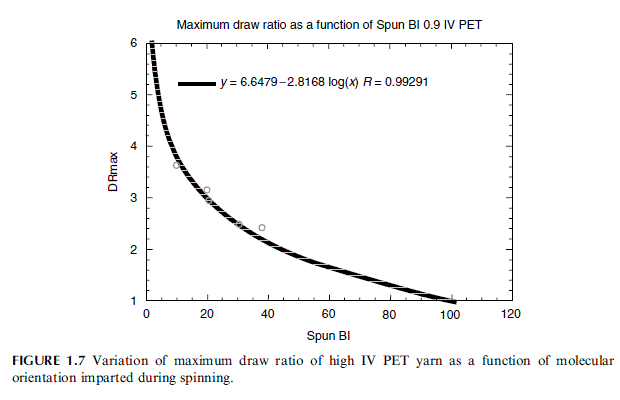Free Textile Article
All about textile & FiberFree Textile Article
All about textile & FiberPET PROCESSING—DRAWING
are often brought about by a separate drawing process. Fiber-forming polymers show a
phenomenon called ‘‘cold drawing on stretching,’’ provided the molecular weight is sufficiently
high to prevent premature breakage. Undrawn fiber produces a distinct ‘‘neck,’’ which
localizes the point of drawing at which deformation and crystallization occur, at once evident
from the change in opacity in the drawn filament due to its optical anisotropy. As-spun PET
fibers can be amorphous or crystalline, depending on the spinning conditions (see Figure 1.5).

All fibers become more crystalline and better oriented when drawn. Faster crystallizing
polymers like PBT, PPT, or nylon-6,6 always form crystalline spun fibers, although
they often need a drawing stage to induce and complete crystallite orientation. The combination
of molecular entanglements and the presence of polymer chain crystallites lock this
orientation into place. This, in turn, affects such parameters as tenacity, modulus, elongation
at break, and heat-shrinkage. The fiber must be drawn close to its maximum draw ratio for
the drawing to be effective. Draw ratio is the ratio of yarn feed velocity to draw-roll haul-off
speed: this ranges from about 1.5 to 6.0. The draw point is the actual place where fiber
necking takes place and it must be stabilized. In early processes, this was done by a heated
metal snubber pin around which the yarn was passed. The pin temperature was set to about
108C above Tg, i.e., about 85–908C for PET process. However, this alone was not sufficient
and the drawn yarn had an unacceptable degree of heat shrinkage. The latter defect was
prevented by heat-setting the fiber by passing it over a long hot plate at about 130–1408C, well
above the effective Tg (~1258C) of the drawn, crystallized yarn. This simple system was
adequate when draw speeds were low (500 m=min), but, as draw speeds rose considerably,
it was necessary to use separately heated feed rolls and draw rolls to achieve the same effect
at much higher speeds. The heated rolls allowed for longer yarn contact times for thermal
transfer, with the yarn wrapped several times around the roll and over an attendant idler
roll. The draw ratio has a major effect on yarn elongation and tenacity. High draw ratios
give high-tenacity yarns with higher yarn moduli and lower extensions to break as expected;
low draw ratios give lower tenacities with higher extensions. Jaffe [34], Ward [35], and
others showed that a consequence of high-speed spinning is to shift the load supporting of
the network chains of the fiber structure from noncrystalline to crystalline regions of the
fiber morphology. This limits the draw ratio available to fully orient these fibers, resulting
in fibers with nearly equivalent tensile properties, but significantly lower shrinkage at an
elevated temperature.


























